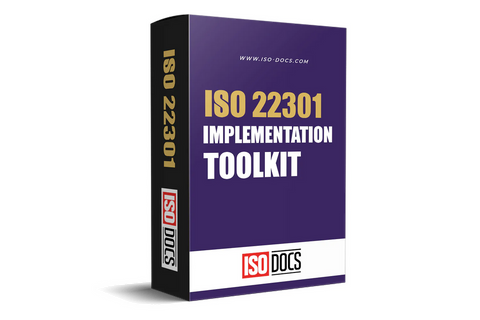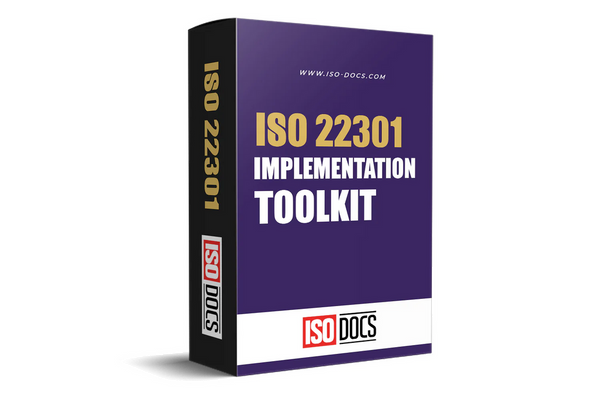ISO 22301: Process Plan Business Continuity Management Template
In today's dynamic business landscape, organizations face an array of potential disruptions that can impede operations. ISO 22301, the international standard for Business Continuity Management Systems (BCMS), provides a systematic approach to safeguarding against such disruptions. To streamline the implementation of ISO 22301, a well-crafted Process Plan is indispensable. Our ISO 22301 Process Plan Business Continuity Management Template is designed to serve as a comprehensive guide, offering a structured framework to organizations aspiring to fortify their resilience.

This template not only aligns with the rigorous requirements of ISO 22301 but also facilitates a tailored and efficient response to unforeseen events. As businesses strive for continuity and resilience, our template becomes an invaluable resource in navigating the complexities of BCM, ensuring a strategic and systematic approach to business continuity planning.
Importance for ISO 22301:Process Plan Business Continuity Management Template
- Compliance with ISO 22301 Standards:The template ensures strict adherence to ISO 22301 standards, serving as a comprehensive guide for organizations aspiring to establish a robust Business Continuity Management System (BCMS).
- Systematic Business Continuity Planning:It provides a structured framework for systematic business continuity planning, ensuring that organizations identify, prioritize, and manage potential disruptions in a methodical manner.
- Risk-Based Approach:The template integrates a risk-based methodology, combining business impact analysis and risk assessment. This facilitates a thorough understanding of risks, allowing organizations to implement strategies for effective risk mitigation.
- Process Orientation:By delineating processes, roles, responsibilities, and dependencies, the template fosters a process-oriented approach. This helps organizations establish clear protocols for business continuity, reducing ambiguity during disruptive events.
- Versatility Across Industries:Designed to accommodate diverse business models and sizes, the template is versatile and applicable across various industries. This adaptability ensures its effectiveness in addressing the unique continuity challenges faced by different organizations.
- Documentation Tool:It acts as a comprehensive documentation tool, enabling organizations to record and maintain essential information related to business continuity processes. This documentation is crucial for audits, reviews, and continuous improvement efforts.
- Facilitates Business Impact Analysis:The template facilitates the crucial process of business impact analysis, allowing organizations to identify and prioritize critical business functions. This analysis forms the foundation for developing targeted continuity strategies.
- Continuous Improvement Mechanism:Through its dynamic nature, the template encourages continual improvement. Regular reviews and updates ensure that the business continuity plan remains aligned with organizational changes and evolving threats.
- Enhanced Organizational Resilience:By providing a roadmap for anticipating, preparing for, responding to, and recovering from disruptions, the template contributes to enhanced organizational resilience. It positions businesses to withstand and recover swiftly from adverse incidents.
- Efficient Resource Allocation:The template aids in efficient resource allocation by identifying the resources necessary for critical business functions. This ensures that resources are allocated judiciously during and after a disruption.
Key components for ISO 22301:Process Plan Business Continuity Management Template
- Scope and Objectives:Clearly define the scope of the business continuity plan, outlining the boundaries within which it applies. Specify the objectives of the plan, ensuring alignment with the organization's overall goals and mission.
- Roles and Responsibilities:Identify and assign specific roles and responsibilities for individuals involved in the business continuity process. This includes key personnel responsible for decision-making, communication, and execution of recovery activities.
- Business Impact Analysis (BIA):Conduct a thorough business impact analysis to identify and prioritize critical business functions. This component assesses the potential impact of disruptions on these functions and sets the foundation for developing effective continuity strategies.
- Risk Assessment:Integrate a comprehensive risk assessment that identifies and evaluates potential threats to business continuity. This includes both internal and external factors that could adversely affect operations.
- Risk Mitigation Strategies:Develop and document strategies for mitigating identified risks. These strategies should be tailored to the specific risks faced by the organization and may include preventive measures, contingency plans, and crisis response protocols.
- Incident Response Plan:Formulate a detailed incident response plan outlining steps to be taken in the event of a disruption. This includes communication procedures, activation of emergency response teams, and initial actions to contain and mitigate the impact of the incident.
- Recovery Plan:Detail the recovery plan, specifying actions and processes to be executed to restore critical business functions to normal operations. This includes resource allocation, alternate site activation, and restoration of key processes.
- Training and Awareness:Implement a training program to ensure that personnel are well-versed in their roles and responsibilities during a disruption. Create awareness campaigns to foster a culture of preparedness and resilience throughout the organization.
- Testing and Exercising:Establish a systematic approach to testing and exercising the business continuity plan. Regular drills and simulations ensure that personnel are familiar with procedures, identify areas for improvement, and validate the plan's effectiveness.
- Documentation and Record Keeping:Maintain comprehensive documentation of the entire business continuity process, including plans, procedures, and test results. Proper record-keeping is essential for audits, reviews, and continuous improvement.
- Communication Plan:Develop a robust communication plan that outlines how information will be disseminated during a disruption. This includes internal and external communication strategies to keep stakeholders informed and minimize confusion.
- Monitoring and Review Mechanism:Establish a mechanism for ongoing monitoring and periodic review of the business continuity plan. This ensures that the plan remains current, relevant, and aligned with changes in the organizational structure, processes, and external threats.
- Documentation of Lessons Learned:Document and analyze lessons learned from testing, incidents, and exercises. Use this information to refine and enhance the business continuity plan, incorporating improvements based on real-world experiences.

Benefits for ISO 22301: Process Plan Business Continuity Management Template
Standards Compliance:
- Ensures compliance with ISO 22301 standards.
- Adhering to ISO 22301 standards ensures that the organization's business continuity practices meet internationally recognized benchmarks, enhancing credibility and demonstrating commitment to resilience.
Enhanced Risk Management:
- Facilitates a robust risk management process.
- The template enables organizations to identify, assess, and mitigate risks systematically, fostering a proactive approach to risk management and minimizing the impact of potential disruptions.
Strategic Continuity Planning:
- Provides a strategic framework for business continuity planning.
- Organizations can develop and implement a structured business continuity plan, aligning it with strategic objectives to ensure the continuity of critical operations during adverse events.
Improved Resilience:
- Enhances organizational resilience.
- By systematically addressing vulnerabilities and preparing for disruptions, the template contributes to increased organizational resilience, enabling quicker recovery and adaptability in the face of unexpected events.
Efficient Resource Utilization:
- Facilitates efficient resource allocation.
- Helps identify and allocate resources judiciously, ensuring that critical functions receive the necessary support during disruptions, preventing resource wastage and optimizing recovery efforts.
Clear Roles and Responsibilities:
- Defines roles and responsibilities clearly.
- The template delineates specific roles and responsibilities, reducing confusion and ensuring that individuals know their duties during a disruption, leading to a more organized response.
Improved Decision-Making:
- Supports informed decision-making during incidents.
- With predefined processes and roles, decision-makers can make timely and informed choices, minimizing downtime and reducing the potential impact of disruptions on the organization.
Enhanced Communication Strategies:
- Improves communication strategies.
- Establishes effective communication plans, both internally and externally, ensuring that stakeholders are promptly informed during incidents, maintaining transparency and trust.
Optimized Recovery Time:
- Speeds up recovery time.
- The template aids in the formulation of efficient recovery plans, reducing the time it takes to restore critical functions, thereby minimizing financial losses and operational downtime.
Continuous Improvement Culture:
- Fosters a culture of continuous improvement.
- Through regular testing, reviews, and updates, the template encourages organizations to continually enhance their business continuity capabilities, staying adaptive to evolving risks and organizational changes.
Documentation for Audits:
- Provides comprehensive documentation for audits.
- Ensures that the organization has detailed records of its business continuity processes, facilitating audits and assessments to validate compliance and effectiveness.
Increased Customer and Stakeholder Confidence:
- Boosts confidence among customers and stakeholders.
- Demonstrating a commitment to business continuity through ISO 22301 compliance and effective planning enhances the confidence of customers, investors, and other stakeholders in the organization's ability to weather disruptions.
Conclusion
In conclusion, the ISO 22301 Process Plan Business Continuity Management Template stands as a pivotal tool in the arsenal of organizations striving for resilience in the face of disruptions. By aligning with international standards, this template ensures a systematic and strategic approach to business continuity planning. The delineation of roles, comprehensive risk management, and the establishment of clear recovery and communication plans contribute to a heightened state of preparedness.
As businesses navigate an increasingly complex and unpredictable landscape, the template not only facilitates compliance but also fosters a culture of continuous improvement. It serves as a dynamic guide, adapting to organizational changes and evolving threats. Ultimately, the template empowers organizations to not only withstand unforeseen challenges but to emerge stronger, ensuring the continuity of critical operations and sustaining confidence among stakeholders.



